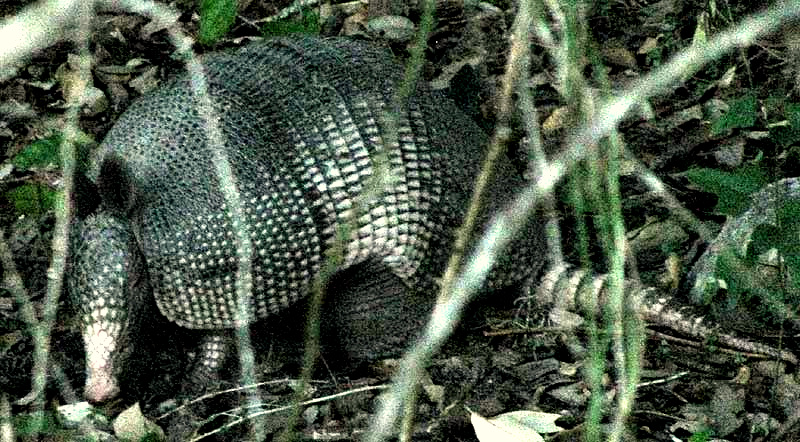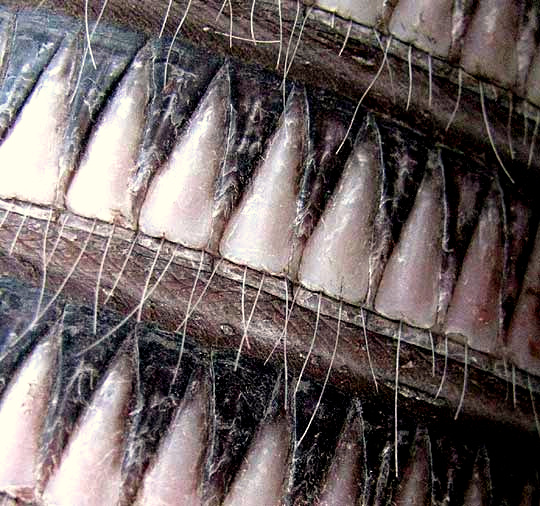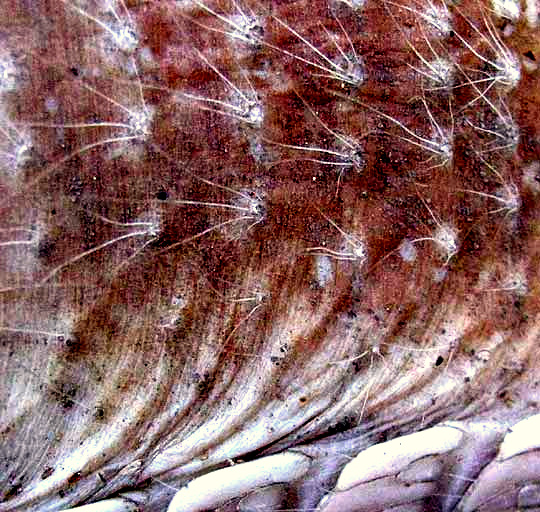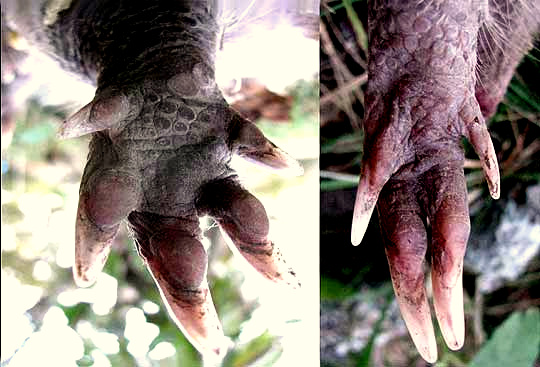Excerpts from Jim Conrad's
Naturalist Newsletter

from the November 11, 2012 Newsletter issued from the valley of the Dry Frio River in northern Uvalde County, southwestern Texas, on the southern border of the Edwards Plateau; elevation ~1750m (~5750 ft); N29.62°, W99.86°; USA
ARMADILLO AT DUSK
Critters have their routines, and lately a certain armadillo has been wandering onto the road we walk at dusk at pretty much the same time each night. Experience suggests that he may do this for a week or two, then disappear, presumably changing to a different route. It's getting dark by the time this armadillo comes out but one night I did get a picture of him as he skittered off the road into the bushes, stopped, and squinted back at me, as you can see in a grainy, low-light photo at the top of this page.
A couple of days after that picture was taken, across the river we came upon a roadkill armadillo, so we were able to get a better look at what makes an armadillo an armadillo. For example, can you imagine what you're seeing below?

Those are the bony scales or plates covering most of the armadillo's top. You're seeing small sections of two of the bands of the Nine-banded Armadillo, DASYPUS NOVECINCTUS, which is the armadillo species we have here. About 10 armadillo genera and 20 species have been described, with other species known as fossils. Armadillo species occur mostly in South and Central America.
The armadillo's underparts aren't covered with plates, as a close-up shows below:

At the bottom of that picture you see the edge of the armadillo's banded, plated top shell. Above that edge is the armadillo's hairy, unprotected belly.

Above you see the undersurfaces of two of the armadillo's feet. At the left the back paw bears five distinct toes and thick calluses, while, at the right, the narrower front foot has only four toes. If you've ever picked up an upset armadillo you might know that you don't have to worry about being bitten, because armadillo teeth are just low, rounded peglike affairs. However, the armadillo's legs are powerful, can scratch at you furiously, and those toenails are hard as bone.
from the June 17, 2001 Newsletter issued from the woods a few miles south of Natchez, Mississippi, USA
ARMADILLOS
At dawn one day this week I was jogging down a forest path near my trailer when I came upon a family of Armadillos -- a mother with 3 half-grown young.
If I hadn't stopped jogging I would have actually tripped over these critters, but that wouldn't have been extraordinary, since Armadillos behave as if they were practically blind. Often you can walk right up to them and they will be looking exactly at you, but they will behave as if they don't see you.
On the other hand, if you get upwind from them, instantly the nose pokes into the air, the critter gets a horrified look in its face, and it waddles off as if the Hounds of Hell were after it. My impression is that armadillo eyes are OK, but they are attached to the armadillos' brains only very loosely, while their noses have superhighway access directly to their brains.
Armadillos have given me a lot of grief in the gardens. They burrow beneath my deer-fences, then during the night dig up enormous parts of the garden. Mostly they are carnivores, eating insects, grubs, worms and such, though sometimes they also eat a few berries, fruits and bird eggs. In the garden they couldn't care less about a cabbage plant or a tomato vine. In the gardens they are looking for earthworms and grubs, which in my highly organic soil are huge and juicy. The damage they do to my plants is purely incidental to their quest for earthworms.
You often see cartoons of Armadillos rolling themselves into cannonball-like spheres, leaving nothing but their bands of armor exposed to enemies. I've never seen an Armadillo do this. I've certainly yelled at them, jumped all around them and even poked at them with my toes trying to get them to do so, but my impression is that ball-rolling is a rare thing with them, if they do it at all.
Around Natchez, maybe 80% of roadkill consists of Armadillos. Nonetheless, they are common as sin.
from the July 28, 2002 Newsletter issued from the woods a few miles south of Natchez, Mississippi, USA
ARMADILLO BLUES
Leon Felkins up near Yokena sends me these lines:
I just had to laugh because I've been through the whole thing, including the have-a-heart trap. If you like your garden but don't have a touch of Zen outlook in your personality, armadillos can drive you bonkers.
Thing is, armadillos (officially known as the Nine-banded Armadillo, DASYPUS NOVEMCINCTUS) love to eat bugs and the grubs that bugs metamorphose from -- and these are just about everywhere in the ground. Armadillos can smell juicy grubs 6 inches underground (15 cm). As Leon points out, they are attracted to fresh dirt. When I plant a tree I know that if I don't put boards or bricks atop the fresh soil, the next day the tree may have been damaged by armadillo digging. Armadillos are closely related to anteaters so they do eat ants. Also snails, carrion (especially relishing the maggots), and small reptiles and amphibians -- including, as Leon points out, the eggs of these.
Zoologists report armadillos doing something I'd just love to see. With the bony shell covering them making them too heavy to float or swim in water, when they must cross a stream they simply walk across the stream's bottom beneath the water. However, if they have a larger body of water to cross, they'll swallow enough air to inflate their stomachs to twice their normal size, providing enough buoyancy to swim across. Afterwards it takes several hours for all the excess air to escape!
Armadillos dig impressive burrows about 8 inches across (20 cm) and up to 25 feet long (7.5 m). Here they especially like burrowing in our orchard and grape arbor and more than once I've fallen into their holes. These holes are especially bad for horses.
Each dusk nowadays, and for the last couple of months or so, a certain armadillo comes up the trail from my toilet and squeezes between two sheets of corrugated tin leaning against my trailer, making a loud scraping racket. You'd not think such a small critter could make such noise, or that a wild animal could stand to be so noisy, but this armadillo just doesn't care. He sniffs and digs a bit beneath the trailer (I hear him grunting and snuffling) then exits beneath my door and continues his nightly rounds. When he finally abandons this itinerary I'll be disappointed, for he's just the kind of guest I like. He comes when he's expected, fulfills his obligations, and then leaves until the next time.
from the March 24, 2007 Newsletter issued from Sierra Gorda Biosphere Reserve Headquarters in Jalpan, Querétaro, MÉXICO
BARBARA'S ARMADILLOS
This week Barbara in Texas qualified for my Gold-Level Bug-Eaten Leaf Award by listing a hundred plants and animals she'd identified in her eastern-Texas neighborhood.
Barbara is one of those people who can't recall a plant or animal without launching into a story about it, and that makes her list especially fun to read. It's full of acid-soil-loving Blackjack Oaks, feral pigs hanging out with javelinas, and her horticultural interests in pawpaws. If you like that kind of rambling, sharp-eyed writing, you can see her list at http://www.backyardnature.net/awards/g-tx-001.htm.
Especially after my gardening years in southwestern Mississippi, when my ankles and hands stayed looking like hamburger because of fire-ant bites, I was gratified by her observations about the relationship between armadillos and fire ants in her area. She writes: